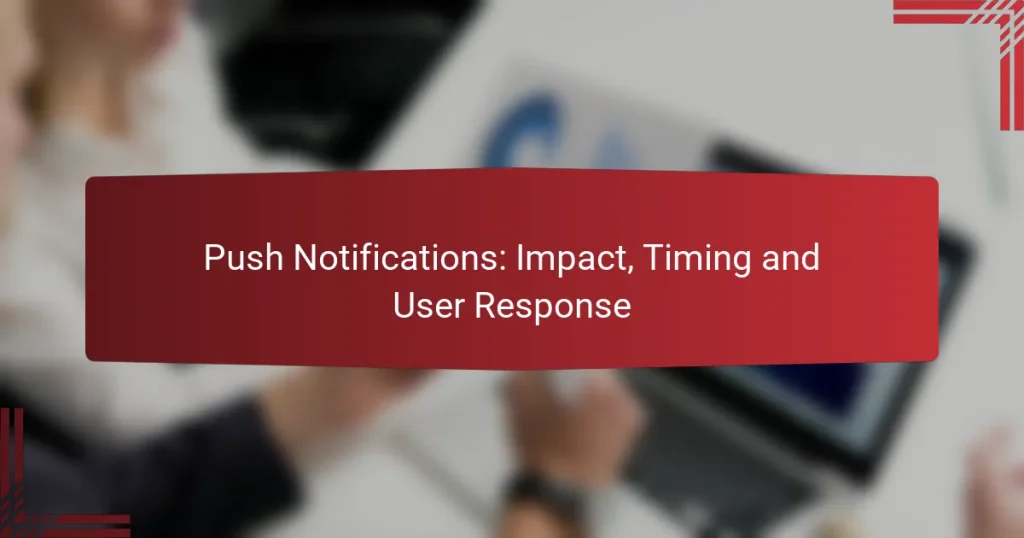User engagement and retention are vital for the success of any business, as they focus on creating lasting relationships with customers. By implementing personalized interactions, loyalty programs, and utilizing data analytics, companies can enhance user experiences and foster a sense of community. These strategies not only keep users interested but also encourage them to return, ultimately driving growth and satisfaction.
User Retention Rates: Strategies, Metrics and Best Practices
Onboarding Processes: Importance, Best Practices and User Experience
Push Notifications: Impact, Timing and User Response
Gamification Techniques: Engagement, Retention and User Motivation
User Feedback: Analysis, Implementation and Engagement Improvement
Re-engagement Strategies: Techniques, Timing and User Retention
What are effective user engagement strategies in the US?
Effective user engagement strategies in the US focus on creating meaningful interactions that keep users interested and returning. These strategies leverage personalization, interactivity, and community to foster loyalty and enhance the overall user experience.
Personalized content recommendations
Personalized content recommendations tailor suggestions based on user behavior, preferences, and demographics. By analyzing data such as past interactions and browsing history, businesses can present relevant content that resonates with individual users, increasing the likelihood of engagement.
For example, streaming services often suggest shows or movies based on what users have previously watched. Implementing algorithms that analyze user data can significantly improve content discovery and retention rates.
Interactive quizzes and polls
Interactive quizzes and polls engage users by inviting them to participate actively rather than passively consuming content. These tools can provide instant feedback and insights, making users feel valued and involved in the experience.
For instance, a brand might create a quiz to help users find products that suit their needs, enhancing the shopping experience while gathering valuable data on user preferences. Ensure that these interactions are easy to share on social media to amplify reach.
Gamification techniques
Gamification techniques incorporate game-like elements into non-game contexts to motivate user engagement. This can include points, badges, leaderboards, and challenges that encourage users to interact more frequently and deeply with the platform.
For example, fitness apps often reward users with badges for completing workouts or reaching milestones, which can boost motivation and retention. When implementing gamification, ensure that rewards are meaningful and aligned with user goals to maximize effectiveness.
Social media integration
Social media integration allows users to connect their accounts, share content, and engage with a community. This strategy can enhance user experience by providing social proof and fostering a sense of belonging among users.
For example, allowing users to share achievements or favorite content on platforms like Facebook or Instagram can drive traffic and attract new users. Make sure to include easy sharing options and encourage users to engage with your brand on social media channels.
Email marketing campaigns
Email marketing campaigns are a direct way to engage users by delivering personalized content, updates, and promotions straight to their inbox. Effective campaigns can significantly enhance user retention by reminding users of your offerings and encouraging them to return.
To maximize impact, segment your email list based on user behavior and preferences, and personalize the content accordingly. Regularly analyze open and click-through rates to refine your strategy and ensure that your emails remain relevant and engaging.
How can businesses improve user retention rates?
Businesses can enhance user retention rates by implementing targeted strategies that focus on customer loyalty and engagement. Effective methods include loyalty programs, regular feedback loops, and exclusive member benefits, each designed to foster a deeper connection with users.
Loyalty programs
Loyalty programs reward customers for repeat purchases or engagement, encouraging them to return. These programs can take various forms, such as points systems, tiered rewards, or cashback offers. For example, a coffee shop might offer a free drink after every ten purchases, incentivizing customers to keep coming back.
When designing a loyalty program, consider the ease of use and the perceived value to the customer. Programs that are too complicated may deter participation, while those that offer meaningful rewards can significantly boost retention. Regularly assess the program’s effectiveness and make adjustments based on user feedback.
Regular feedback loops
Establishing regular feedback loops allows businesses to understand user needs and preferences better. This can be achieved through surveys, direct communication, or monitoring user behavior. For instance, a software company might send out quarterly surveys to gather insights on user satisfaction and feature requests.
Acting on feedback is crucial; users are more likely to stay engaged when they see their input valued. Implement changes based on feedback and communicate these updates to users, reinforcing their importance in the decision-making process.
Exclusive member benefits
Offering exclusive member benefits can create a sense of belonging and enhance user loyalty. These benefits might include early access to new products, special discounts, or members-only content. For example, an online retailer could provide exclusive sales events for members, making them feel valued and appreciated.
To maximize the impact of these benefits, ensure they are relevant and appealing to your target audience. Regularly review and refresh these offerings to maintain interest and engagement, and promote them effectively through your marketing channels.
What role does data analytics play in engagement?
Data analytics is crucial for enhancing user engagement by providing insights into user behavior and preferences. By analyzing data, businesses can tailor their strategies to meet user needs, leading to improved retention and satisfaction.
User behavior tracking
User behavior tracking involves monitoring how users interact with a product or service. This can include tracking clicks, time spent on pages, and navigation patterns. Understanding these behaviors helps identify what features engage users the most and which areas may need improvement.
For effective tracking, utilize tools like Google Analytics or Mixpanel to gather data. Regularly review this information to spot trends and adjust your engagement strategies accordingly.
Segmentation analysis
Segmentation analysis divides users into distinct groups based on shared characteristics, such as demographics, behavior, or preferences. This allows businesses to create targeted marketing campaigns and personalized experiences that resonate with each segment.
To implement segmentation, consider factors like user age, location, and purchase history. Tailoring content and offers to specific segments can significantly enhance engagement and retention rates.
Predictive modeling
Predictive modeling uses historical data to forecast future user behavior. By applying statistical algorithms and machine learning techniques, businesses can anticipate user needs and preferences, enabling proactive engagement strategies.
For example, if data shows that users who engage with a specific feature are likely to convert, focus on promoting that feature to similar users. Regularly update your models with new data to maintain accuracy and relevance.
What are the best tools for measuring engagement?
The best tools for measuring engagement provide insights into user behavior, helping businesses understand how effectively they connect with their audience. Key tools include Google Analytics, Hotjar, and Mixpanel, each offering unique features to track and analyze user interactions.
Google Analytics
Google Analytics is a widely used platform that tracks website traffic and user interactions. It provides metrics such as page views, session duration, and bounce rates, allowing businesses to assess user engagement levels effectively.
To get started, set up tracking codes on your website and define goals to measure specific actions, like form submissions or purchases. Regularly review reports to identify trends and areas for improvement.
Hotjar
Hotjar focuses on visualizing user behavior through heatmaps and session recordings. This tool helps businesses understand where users click, scroll, and spend time on their site, providing a clear picture of user engagement.
Implementing Hotjar requires adding a tracking code to your site. Use the insights gained to optimize page layouts and enhance user experience, ensuring that key content is easily accessible.
Mixpanel
Mixpanel specializes in tracking user actions and events, offering detailed insights into user engagement over time. It allows businesses to analyze user retention and conversion rates, making it easier to identify successful strategies.
To utilize Mixpanel, define the events you want to track and set up funnels to visualize user journeys. Regularly analyze the data to refine marketing efforts and improve user retention strategies.
What are the prerequisites for a successful engagement strategy?
A successful engagement strategy requires a deep understanding of your audience and a well-aligned content strategy. These prerequisites ensure that your efforts resonate with users and keep them coming back.
Clear target audience definition
Defining a clear target audience is crucial for effective engagement. This involves identifying demographics, interests, and behaviors that characterize your ideal users. For instance, a tech company might focus on young professionals aged 25-35 who are interested in the latest gadgets.
Utilize tools like surveys, analytics, and social media insights to gather data on your audience. Segmenting your audience into distinct groups can help tailor your messaging and improve engagement rates.
Content strategy alignment
Your content strategy must align with the interests and needs of your target audience. This means creating relevant, valuable content that addresses their pain points and preferences. For example, if your audience seeks educational resources, consider developing how-to guides or webinars.
Regularly review and adjust your content strategy based on audience feedback and engagement metrics. Aim for a mix of content types, such as articles, videos, and infographics, to cater to different preferences and keep your audience engaged.
How can affiliate marketing enhance user retention?
Affiliate marketing can significantly boost user retention by creating a mutually beneficial relationship between businesses and their affiliates. This strategy incentivizes affiliates to promote products or services, which can lead to increased customer loyalty and repeat purchases.
Affiliate rewards programs
Affiliate rewards programs are designed to encourage users to engage more with a brand by offering incentives for referrals and purchases. These programs can include cash rewards, discounts, or exclusive access to products, which motivate users to remain active and loyal.
To implement an effective affiliate rewards program, businesses should consider the types of rewards that resonate with their target audience. For instance, offering a tiered reward system can enhance engagement, where users earn greater rewards as they refer more customers or make more purchases.
Common pitfalls include setting rewards that are too low to motivate action or making the redemption process overly complicated. A straightforward and appealing rewards structure can significantly enhance user retention and satisfaction.






